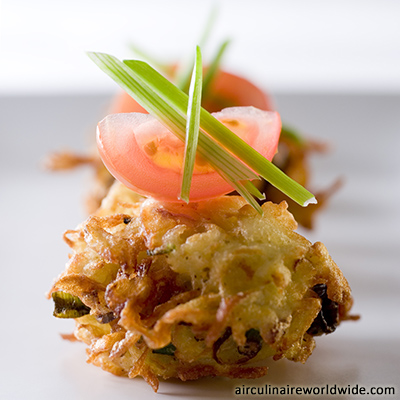The potato, first discovered in the New World, has played a powerful role in the history of many European nations. Switzerland is no different. Winter survival strategies governed much of what was considered “local cuisine” in a given area. The potato is the perfect carbohydrate package. It grows in a variety of soils and can be stored and eaten in the snowy winter when other resources are dormant.
Potatoes are prevalent in Bavarian cuisine, so it was only natural that the German affinity for the potato would accompany the language into Switzerland. The prevalence of the Rösti was once thought of as the dividing line between the German-speaking (Schweizerdeutsch) part of Switzerland and the French- and Italian-speaking regions.
The preparation is so simple that local variations (addition of apples or bacon and, of course, cheese) would often give a peek into common agricultural practices in a given area. While the recipe is simple, the technique takes patience.
Ingredients
- 1 lb. (450 g) Coarse Ground Russet Potato (about 2-3 large ones)
- 2 oz. (60 g) Unsalted Butter
- 1 oz. (30 g) Vegetable Oil (Vegetable oil will slow the “butter browning” effect and allow you to cook the pancake slightly longer to ensure the interior potatoes are cooked.)
- To Taste, Sea Salt
Directions
- Place potatoes in pot of cold water and cook until tender.
- Remove from pot and allow cooling to room temperature.
- Peel cooled potatoes. Then, refrigerate.
- Grate potato with cheese grater. Note: Cold potatoes grate more easily than warm ones.
- Heat 8-inch / 20-cm skillet to medium high.
- Add butter and oil, and, once butter is melted, add potatoes.
- With spatula, even out potato. Then, push down sides so shape is round.
- “Wiggle” pan to ensure no potatoes are stuck on bottom, and everything is browning at same rate.
- Once bottom is brown, turn over Rösti.
- In small pan, you may be able to flip it with spatula. In larger pan, you will need to use plate or something in which to place Rösti into before flipping it back into pan.
- Trick is not to “break” Rösti for presentation later.
- Care must be taken here, as there may be hot liquid fat with which you must contend, as well.
- Once Rösti is crisp on both sides, simply remove it from pan and place on plate, season with salt and pepper, and cut into wedges.
The diversity of the Rösti is rooted in its simplicity and the ability to change the flavor profile to whatever you want. The bonus is: It works great on an airplane!
We invite you to try the Veal Chop on our menu served with Rösti potatoes.
Enjoyed making this recipe? Follow us on Instagram and Twitter and tag your culinary creations with #ACWrecipes. Have questions? Tweet @airculinaire.





